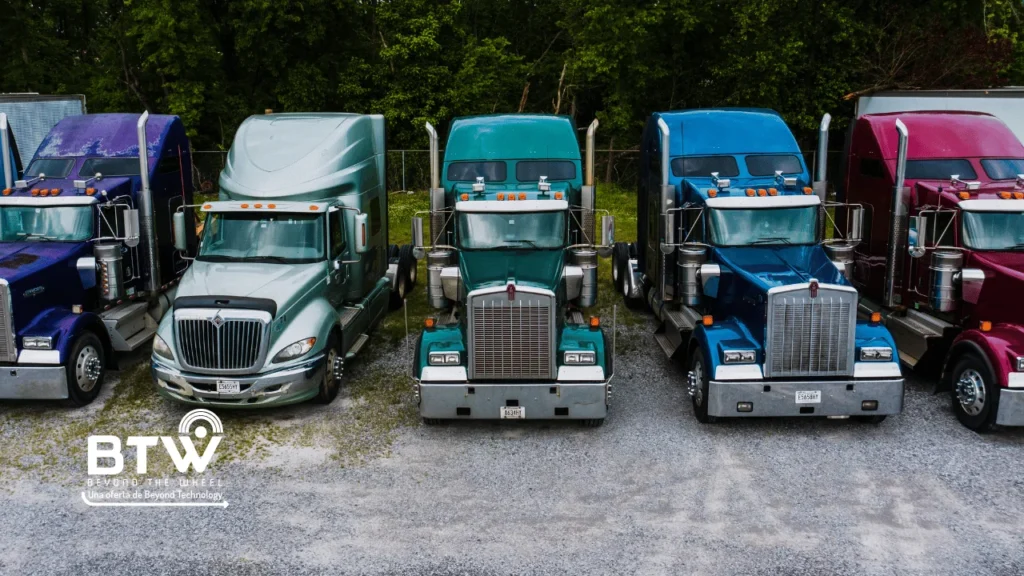Advantages of using a real-time Tire Monitoring System for fleets

Efficient management of a vehicle fleet requires a comprehensive approach that considers all critical elements for its operation. Among these, the condition of the tires is often overlooked until costly failures or avoidable accidents occur. Implementing a real-time monitoring system allows companies to anticipate problems, optimize resources, and reduce risks, resulting in a direct impact on profitability and operational safety. Smart alerts to prevent failures before they happen Having sensors that detect deviations in tire pressure or temperature enables timely detection of potential incidents. These alerts allow fleet managers to make quick decisions before an anomaly leads to an accident or the loss of a vehicle. Unlike manual inspections, which rely on human judgment and are not always performed frequently enough, real-time systems operate continuously, without interruptions, and with a level of precision that minimizes errors. This anticipatory capability improves the safety of both the driver and the cargo, while also preventing unnecessary service interruptions. Reducing operating costs through predictive maintenance One of the most significant benefits of these technological platforms is the ability to implement more efficient maintenance strategies. By having continuous data on tire conditions, companies can schedule inspections only when necessary, rather than following routine checks or reacting to failures. This approach reduces the number of unplanned stops and optimizes the use of workshops and technical resources. In the medium term, it translates into lower expenses related to replacing damaged tires and less downtime for vehicles. In addition to operational benefits, using a real-time monitoring system provides greater security in managing the fleet’s most valuable assets. Thanks to the traceability and constant tracking of each tire’s condition and location, companies can prevent risky practices such as reselling or swapping tires for worn-out ones at illegal shops. This ensures that the tires installed on each vehicle are always the original ones and remain in optimal condition for use, protecting the investment and reducing the risk of accidents caused by unauthorized or unsafe components. Maximizing tire performance and durability Monitoring systems provide accurate information about conditions that directly affect tire wear, such as improper pressure or overheating. Adjusting these factors in real time allows tires to operate within optimal parameters, significantly extending their lifespan. This not only means direct savings on purchasing new tires but also contributes to more efficient and stable driving, reducing fuel consumption and improving the vehicle’s overall performance. The benefits of adopting these solutions are clear: enhanced safety, reduced costs, and better resource utilization. If you want to learn more about how to optimize your fleet’s operation with intelligent monitoring technology, reach out to Beyond The Wheel and speak with one of our advisors.
5 key benefits of implementing telematics in commercial vehicle fleets

Efficient fleet management has evolved from a manual task into a strategic operation powered by data. Within this transformation, telematics has emerged as a critical technology that enables real-time, accurate monitoring, delivering tangible benefits in operational efficiency and cost reduction. Companies that adopt this solution not only optimize their resources but also strengthen their responsiveness and continuous improvement capabilities. Reducing operational expenses through predictive maintenance One of the most noticeable advantages of advanced monitoring systems is the reduction in costs associated with reactive maintenance. With real-time data on each vehicle’s mechanical condition, fleet managers can anticipate issues, schedule preventive servicing, and avoid expensive breakdowns that hinder operational availability. Constant monitoring of indicators such as engine temperature, tire pressure, and oil levels enables proactive decision-making, ultimately extending the lifecycle of fleet assets. Enhancing route efficiency with live location insights Access to the exact location of each unit enables far more effective route planning. Telematics technology identifies traffic patterns, adverse weather conditions, and unauthorized route deviations, all of which directly affect delivery times and fuel consumption. This allows companies to dynamically adjust routes, eliminate unnecessary mileage, and improve punctuality on deliveries. Improving driver performance in commercial fleets Data generated by telematics systems also helps detect driving behaviors that lead to excessive wear or increased accident risk. Hard braking, sudden acceleration, and excessive idling are examples of habits that can be corrected through training, automated alerts, or policy adjustments. This shift in driving style directly enhances safety and fuel efficiency, promoting a more sustainable and responsible fleet operation. Streamlining working hours in logistics operations Automated records provide detailed insights into shift start and end times, as well as periods of idleness or delays. This level of visibility supports better workload organization, more accurate shift planning, and compliance with labor regulations. It also helps redistribute human resources more equitably and identify potential process bottlenecks. Making strategic decisions with reliable operational data The consolidated information from these systems offers a comprehensive view of fleet performance. This analytical capability helps refine business strategies with greater accuracy, from vehicle replacement planning to the evaluation of new route opportunities. Continuous access to key metrics supports more agile and result-oriented decision-making focused on long-term growth. To learn more about how these solutions can enhance the performance of your commercial fleet, speak with a specialist at Beyond The Wheel. Discover how to take your logistics operation to the next level with precision-driven technology.
Sensors and Telemetry: What Are the Best Options for Monitoring Your Fleet?

Efficient management of commercial vehicles involves more than just maintenance and route planning. Real-time monitoring, powered by advanced sensors and telemetry systems, has become essential for companies aiming to optimize operational performance. As technology evolves, various smart solutions emerge that provide full fleet visibility, enhance safety, and lower operating costs. Differences Between GPS Tracking, Tire Pressure, and Temperature Sensors in Cold Chain Transport Each type of sensor plays a specific role in logistics operations. GPS trackers provide accurate vehicle location, help detect unauthorized routes, and improve delivery times. Tire pressure sensors, on the other hand, help prevent accidents due to deflation or wear, extend tire lifespan, and reduce fuel consumption. In refrigerated units, temperature sensors are critical to ensure product quality throughout the journey, particularly in the food and pharmaceutical industries. While these tools can function independently, their full potential is unlocked when integrated into a unified management system. This technological convergence allows critical data to be centralized and decisions to be made based on accurate, real-time information. Benefits of Advanced Vehicle Data Collection Systems in Logistics Using telemetry platforms with connected sensors transforms how a fleet is managed. These tools gather detailed data on driver behavior, fuel consumption, idling time, harsh braking, and predictive maintenance. This visibility improves operational efficiency while enabling safer and more sustainable driving policies. With both historical and live analytics, logistics teams can anticipate failures, reduce downtime, and better plan maintenance cycles. The result is a more cost-effective operation, less asset wear, and a more reliable service experience for end customers. How to Choose a Comprehensive Monitoring Solution with Smart Fleet Sensors Implementing vehicle monitoring technology goes beyond purchasing hardware. Real value lies in selecting a system tailored to the company’s specific needs—scalable, integrative, and supported by technical expertise for seamless deployment. An effective solution should support multi-sensor integration, intuitive dashboards, and customizable reporting capabilities. Interoperability with ERP or logistics platforms is key to achieving true process automation. Partnering with a provider that offers ongoing advisory services ensures the investment evolves alongside business demands. To learn how these technologies can transform your operations, we invite you to speak with a Beyond The Wheel advisor. Our team is ready to help you find the most suitable solution for your fleet.
How to Choose the Best GPS Tracking Solution for Transportation Fleets
Operational efficiency and road safety have become strategic priorities for transportation companies. In this context, having a reliable GPS tracking system is no longer a competitive advantage, it’s a critical necessity. Choosing the right technology involves evaluating more than just price; it’s about understanding which capabilities will truly impact fleet management. Vehicle tracking systems with a high level of security One of the most important factors to consider when selecting a provider is the level of protection offered, both in data handling and vehicle integrity. A strong system should include advanced encryption mechanisms, tiered user access, and proactive alerts in case of tampering or device disconnection. Additionally, cloud data backup must ensure service continuity even if the installed equipment fails. Real-time monitoring platforms for operational control The ability to instantly view the exact location of each unit enables quick decisions in the face of route deviations, unauthorized stops, or delays. This functionality improves coordination with drivers and reduces idle time, ultimately boosting productivity. It’s essential to verify that the platform provides an intuitive interface, is compatible with various devices, and remains consistently available to authorized personnel. Data analytics tools to optimize routes and maintenance Beyond simply knowing where each vehicle is, the most advanced solutions offer predictive analytics to identify patterns in fuel consumption, driving habits, or critical wear points. This information is vital for reducing operating costs, preventing accidents, and extending vehicle lifespan. A system that transforms data into actionable insights creates real competitive advantages over time. Having the right technology can mean the difference between a reactive operation and an intelligent one. If you’re thinking about upgrading your fleet management system, discover how Beyond The Wheel can help you implement tracking solutions tailored to your specific needs. Talk to an advisor and transform your operation with accurate, real-time information.
Signs of fuel inefficiency in your truck fleet

Fuel performance is one of the clearest indicators of operational efficiency in a transportation fleet. When trucks begin consuming more diesel than usual, the impact is directly reflected in operating costs, route profitability, and premature asset wear. Detecting inefficiency early allows you to make strategic decisions to correct deviations and keep vehicle productivity at optimal levels. Frequent fluctuations in fuel efficiency per mile When fuel usage per mile becomes unstable without a clear operational cause, it’s likely that an underlying issue is present. These variations may be linked to mechanical failures, worn-out tires, or even poor driving habits. Real-time monitoring helps identify unusual patterns and determine whether the issue is technical, logistical, or human. Premature wear on key engine system components Well-managed preventive maintenance allows you to detect when the engine is working harder than it should, resulting in increased fuel consumption. Indicators such as rising operating temperatures, higher emissions, or loss of power should be addressed immediately. These conditions can lead to a cycle of inefficiency that impacts not only fuel usage but also the vehicle’s lifespan. Driving behavior that increases fuel consumption The way drivers operate trucks directly affects tank performance. Hard braking, unnecessary acceleration, and long idle times are habits that quietly drive up fuel usage. A properly implemented telematics system not only detects these behaviors but also enables training programs and individualized follow-ups to improve driving practices. Fuel efficiency is not a matter of chance; it results from continuous oversight, applied technology, and informed decisions. At Beyond The Wheel, we offer solutions designed to help you optimize every mile traveled. Talk to one of our advisors and discover how to reduce operating costs with smart monitoring strategies.
How jammer attacks affect your company’s productivity

Jammer attacks pose a growing threat to businesses that rely on connectivity for their daily operations. These interference devices block GPS, Wi-Fi, and cellular signals, disrupting communication and asset tracking. In industries such as logistics and transportation, their impact results in financial losses, operational delays, and security risks. Disruption of satellite tracking and supply chain losses The use of jammers in the logistics sector interferes with telematics and real-time monitoring systems, preventing the tracking of fleets and goods. Without this visibility, companies cannot react promptly to route deviations or theft, increasing the risk of financial losses and affecting relationships with customers and suppliers. Additionally, the lack of accurate data impacts route planning, causing delivery delays and raising operational costs. Impact on operational efficiency and driver safety When a jammer disrupts fleet communication, drivers lose contact with the control center, making emergency response more difficult. Furthermore, the absence of data on vehicle status and road conditions reduces the ability to optimize fuel consumption and driving times. These interruptions negatively impact overall business productivity and can compromise driver safety on the road. Strategies to mitigate the impact of signal blockers To minimize the effects of jammers, companies must implement advanced detection and response solutions. Using tracking systems with multiple connectivity technologies, such as GPS combined with IoT networks, helps reduce vulnerability. Additionally, training staff in security protocols and using intelligent monitoring tools allow businesses to detect sabotage attempts in real-time. Protecting connectivity infrastructure is essential to preventing disruptions that impact productivity and security. Learn more about how to mitigate these risks and strengthen your company’s operations with guidance from Beyond The Wheel.
Impact of driver fatigue on the operating costs of transport companies

Driver fatigue is one of the main threats to the profitability of transport companies. Drivers experiencing physical and mental exhaustion have slower reaction times and reduced attention capacity, increasing the risk of accidents. These situations not only affect road safety but also generate significant costs due to vehicle damage, operational disruptions, and rising insurance premiums. How fatigue-related accidents affect profitability in freight transport When a fatigued driver loses control of their vehicle, the consequences can be severe. A crash can result in financial losses related to vehicle repairs, compensation payments, and delivery delays. Additionally, companies face penalties and stricter regulatory inspections, impacting their reputation and reliability with clients. These factors make fatigue not just a safety issue but a direct threat to business sustainability. The role of technology in preventing drowsiness-related road incidents To mitigate fatigue-related risks, many companies have adopted advanced technological solutions. AI-powered monitoring cameras can detect signs of drowsiness in real time, alerting both the driver and the control center before an incident occurs. These systems enable timely intervention and help reduce accidents, leading to lower operational costs and greater fleet management efficiency. Benefits of smart cameras for enhancing safety in commercial fleets Beyond detecting signs of fatigue, advanced cameras provide detailed insights into driving habits. With these tools, operators can receive training based on real data, improving their performance and fostering a culture of safe driving. By minimizing risk events, companies can reduce accident-related costs, extend vehicle lifespan, and strengthen their competitiveness in the industry. Implementing intelligent monitoring technologies is a strategic investment for any transport company. To learn more about these solutions and how Beyond The Wheel can help optimize your fleet’s safety, schedule a consultation with one of our experts.
Tire wear signs that can cost your fleet dearly

Maintaining a vehicle fleet requires special attention to the condition of the tires, as their wear not only compromises driver safety but also impacts operating costs. Identifying signs of deterioration in time can make the difference between a safe trip and costly unexpected repairs. How to identify irregular wear in commercial tires One of the first signs of tire problems is uneven tread wear. When the contact surface with the road does not wear evenly, it may be due to poor alignment, improper pressure calibration, or suspension failures. This not only reduces the tire’s lifespan but also increases fuel consumption by creating greater rolling resistance. Constant monitoring helps detect abnormal patterns and correct them before they generate additional costs. The impact of improper pressure on tire lifespan Incorrect tire pressure is one of the leading causes of premature wear and unexpected failures. If the pressure is too low, the tire experiences accelerated wear on the sides and an increased risk of overheating, which can lead to blowouts. On the other hand, excessive inflation reduces traction and concentrates wear in the center of the tread. Implementing real-time monitoring systems helps maintain optimal pressure levels and prevent incidents that could affect fleet operations. How telemetry technology optimizes tire management The use of technological solutions allows precise monitoring of tire conditions in each fleet unit. Advanced telemetry systems collect real-time data on pressure, temperature, and wear, enabling proactive management. This information helps prevent unexpected failures and schedule timely maintenance, optimizing resources and reducing costs from unforeseen repairs. Integrating these tools not only improves safety but also extends tire life and reduces fuel consumption. With the support of specialized solutions, it is possible to minimize risks and maximize operational efficiency. To learn how technology can optimize tire management in your fleet, speak with a Beyond The Wheel advisor and get detailed insights on the best options for your company.
How to Optimize Fuel Usage with Sensors and Telematics in Fleets

Fuel consumption is one of the highest operating costs for transportation and logistics companies. Adopting technologies like telematics and smart sensors helps improve fuel efficiency, reduce waste, and extend vehicle lifespan. Implementing these solutions not only impacts profitability but also contributes to lowering the fleet’s environmental footprint. Real-time monitoring to improve fuel performance Using sensors connected to telematics systems allows real-time analysis of each unit’s performance. These devices collect data on driving habits, speed, RPM, and idling time, among other factors that directly influence fuel consumption. By analyzing this information, companies can identify inefficient patterns and implement corrective strategies such as driver training or route optimization. Additionally, continuous monitoring helps detect mechanical failures that may be affecting performance, enabling preventive action before they become major issues. Reducing diesel consumption with advanced telematics alerts The most advanced telematics platforms provide real-time alerts for behaviors that increase fuel consumption, such as sudden acceleration or unnecessary braking. These notifications help correct driver actions on the spot and encourage more efficient driving. Predictive analytics tools can also anticipate when a vehicle is consuming more fuel than usual, making it easier to schedule preventive maintenance. This not only helps reduce costs but also minimizes fleet downtime and improves operational planning. Route optimization and reduction of unnecessary mileage Another key factor in reducing fuel consumption is route planning based on telematics data. These systems help avoid routes with heavy traffic, steep inclines, or poor road conditions that may affect engine efficiency. Artificial intelligence in these platforms enables dynamic recommendations to adjust routes based on real-time traffic conditions. By minimizing unnecessary mileage, companies can lower fuel expenses without compromising delivery schedules. Discover how to optimize your fleet’s performance Implementing sensors and telematics is essential for reducing operational costs and improving fuel efficiency in transportation fleets. Beyond The Wheel offers specialized solutions for companies looking to optimize their operations with advanced technology. Speak with an advisor today and learn how this innovation can benefit your business.
What is real-time GPS tracking and why is it essential for your fleet?
Managing an efficient vehicle fleet requires advanced tools that provide real-time insights into each unit’s location and performance. Real-time GPS tracking has become a crucial resource for optimizing operations, enhancing security, and reducing operational costs. This technology delivers precise data on vehicle location, speed, and driver behavior, facilitating strategic decision-making. How satellite monitoring improves operational efficiency Real-time GPS tracking enables precise vehicle location monitoring, optimizing route planning and minimizing unnecessary travel time. With live data, fleet managers can make informed decisions regarding detours, delays, or road incidents. This not only streamlines the delivery of goods and services but also helps reduce fuel consumption and vehicle wear and tear. Additionally, having accurate data on vehicle usage allows companies to detect inefficient driving patterns and implement strategies to correct them. This results in better resource allocation and significant cost reductions. Driver behavior monitoring and risk reduction Fleet monitoring goes beyond vehicle location—it also analyzes driver performance. Through real-time sensors and alerts, companies can identify risky driving habits such as harsh braking, sudden acceleration, or speeding. This data enables the implementation of corrective measures and training programs focused on improving road safety. Reducing road incidents minimizes downtime due to accidents and helps protect both drivers and transported goods. Enhanced security with alerts and smart geofencing Another key benefit of real-time GPS tracking is the ability to set up automatic alerts in case of irregular situations. Geofencing technology allows companies to establish virtual perimeters and receive notifications if a vehicle enters or leaves an unauthorized area. This is particularly useful in preventing theft and route deviations, offering greater control over fleet operations. In case of an emergency, live location tracking enables a quick and efficient response, whether assisting a driver in distress or recovering a lost vehicle. These security tools reinforce customer confidence and protect company assets. Optimize your fleet with Beyond The Wheel Real-time GPS tracking is an essential solution for businesses looking to improve operational efficiency and reduce risks. With advanced monitoring and control tools, companies can make more strategic decisions and ensure better fleet performance. To learn more about these solutions and receive expert guidance, consult with a specialist at Beyond The Wheel.